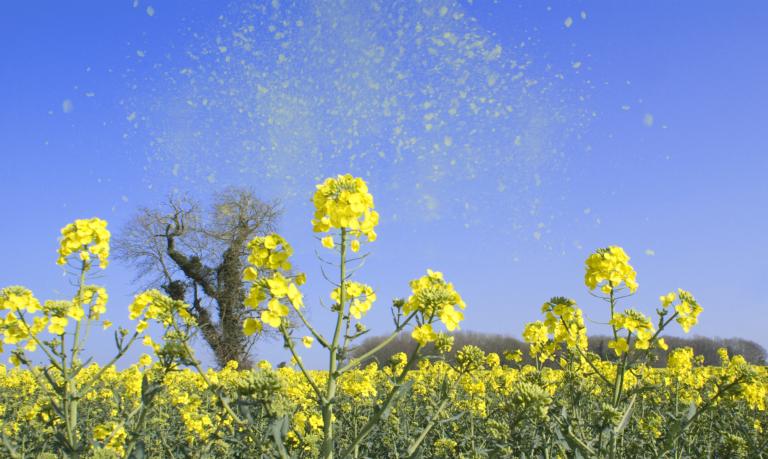
Researchers from Naturalis have developed a new method for DNA analysis that reveals which types of pollen are drifting around in the air and in which quantities far more accurately. This approach also clarifies why the hay fever season currently seems to last throughout the entire year.
Monitoringpollen
Now that the prevalence of hay fever is increasing, measuring the quantities and types of allergenic pollen in the air is a global socioeconomic challenge. The traditional way of determining that is to examine the pollen grains captured in pollen traps under the microscope. That yields important information for hay fever patients, but it is also time-consuming work that requires highly educated specialists. Consequently, there is a demand for new techniques to automate this process.
Researchers from Naturalis applied methods for DNA analysis that do not examine the pollen grains but the DNA these contain. This new approach can be used to examine the DNA from many different types of pollen simultaneously. The pollen samples are taken from two Dutch pollen monitoring stations, which focus on the three most frequently occurring allergenic plant groups that blossom in the early spring or autumn.
Accurate at the species level
One of the monitoring stations is located on the roof of the Leiden University Medical Center (LUMC) in Leiden, and the other is on the roof of the Elkerliek hospital in Helmond. The DNA research was carried out at Naturalis Biodiversity Center in Leiden. The technique used, DNA metabarcoding, makes it possible to recognize and count pollen at the species level, whereas with a microscope, this is usually only possible at the family level. Consequently, the technique provides a far more accurate picture, as demonstrated by scientists from Naturalis, University of Oslo, Leiden University of Applied Sciences and two hospitals involved in an article in the journal Science of the Total Environment.
Furthermore, the scientists discovered that DNA from pollen remains intact in microscope samples. For several decades, microscope samples have been acquired at pollen monitoring stations worldwide on a daily basis, and these are now accessible for DNA research. The DNA marker used can distinguish both highly allergenic and hybrid plant species from related species, which cannot be identified with other DNA markers or microscopic research.
Hay fever in December
 The marker makes it possible to investigate which pollen allergen is present and from which plant species it originates. Nowadays, many people already complain about hay fever in December. Ecologist Marcel Polling from Naturalis: “A journalist from NOS news asked me how that is possible, so I went and found out. There is a cultivated hybrid species of alder that has allergenic pollen, which is planted in many cities and already blossoms in December. We can obtain new insights like these thanks to this type of DNA research on pollen samples.”
The marker makes it possible to investigate which pollen allergen is present and from which plant species it originates. Nowadays, many people already complain about hay fever in December. Ecologist Marcel Polling from Naturalis: “A journalist from NOS news asked me how that is possible, so I went and found out. There is a cultivated hybrid species of alder that has allergenic pollen, which is planted in many cities and already blossoms in December. We can obtain new insights like these thanks to this type of DNA research on pollen samples.”
“Furthermore, we discovered that pollen from an exotic species, Parietaria officinalis (lichwort), is becoming increasingly prevalent in the Netherlands due to climate change. This plant originates from the Mediterranean area, but its prevalence here has increased over the past ten years due to increased temperatures. Lichwort thrives particularly well in urban areas, and its pollen is highly allergenic. In addition, the pollen cannot be distinguished from the pollen of non-allergenic stinging nettles.”
Beteresteden
 Polling: “A growing number of people are experiencing increasingly longer hay fever periods, which seem to last throughout the entire year. The cause of this lies in new allergenic plant species that are establishing in the Netherlands, the planting of exotic species, and the longer blossoming periods of native species. Without the use of our method for DNA analysis on old pollen samples, we would never have discovered this.”
Polling: “A growing number of people are experiencing increasingly longer hay fever periods, which seem to last throughout the entire year. The cause of this lies in new allergenic plant species that are establishing in the Netherlands, the planting of exotic species, and the longer blossoming periods of native species. Without the use of our method for DNA analysis on old pollen samples, we would never have discovered this.”
“The use of DNA for analysis is a fantastic research method because it can be used in many different areas and provides us with increasingly accurate information. Residents’ allergies can now be taken into account when designing towns and cities, and other species of street trees can be planted. That will make it easier for hay fever patients to live in our towns and cities.”